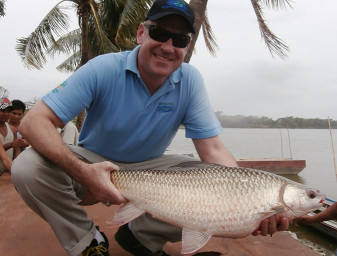Technical advisor to Southeast Asia discusses how agriculture, aquaculture grow together
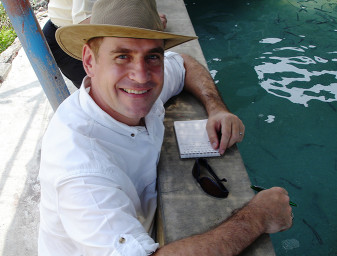 Aquaculture has been Lukas Manomaitis’ passion ever since he went on a trip to Belize as a sophomore in high school to see tropical reef systems. Once the Massachusetts native realized that aquaculture was for producing food and not filling aquariums, he embarked on an educational and career path that has taken him around the world, including a stint with the Peace Corps in Fiji and some time in Alabama doing research on Gulf of Mexico red snapper.
Aquaculture has been Lukas Manomaitis’ passion ever since he went on a trip to Belize as a sophomore in high school to see tropical reef systems. Once the Massachusetts native realized that aquaculture was for producing food and not filling aquariums, he embarked on an educational and career path that has taken him around the world, including a stint with the Peace Corps in Fiji and some time in Alabama doing research on Gulf of Mexico red snapper.
Manomaitis now lives with his family in Bangkok, Thailand, where his contract with the U.S. Soybean Export Council (USSEC) allows him to explore multiple opportunities in a region of the world where aquaculture is embraced. Despite offers to work in the United States, he’s always viewed Asia as the hub of global aquaculture activity. The Southeast Asia senior technical advisor for USSEC’s aquaculture program talks with the Advocate about the symbiotic partnership that the soy industry has formed with fish farmers and trends he sees in fish production.
Aquafeeds use a lot of soy. But the aquaculture industry is still a relatively small consumer of soy, compared to other industries. Where does aquaculture’s soy consumption stand in terms of other agriculture sectors?
In terms of volume, the poultry and the swine industries each have about 400 million metric tons (MMT) of feed being produced. Aquaculture has around 50 MMT. Though the volume of aquaculture feeds is still very much lower than the other terrestrial livestock industries the amount of soy that’s being used in aquaculture is increasing. We used to talk about soy as a fishmeal replacement, but it’s no longer really that, it’s now just a regularly used ingredient found in most aquaculture feeds. Depending on species, there is a range for how much you can put in. For omnivorous species like tilapia, you can probably safely put in up to 55 percent, but in the real world you probably wouldn’t do that, as on a least cost feed formulation basis it wouldn’t make sense at this point in time. What USSEC has done over the past few decades to aid industry is to identify the maximum amount of soy that can be used in feeds for specific species before you have a negative performance effect. This information can help formulators when they are trying to be more aggressive to create high quality, but lower cost, aquafeeds.
How do you characterize the growth over the past decade and what the soy-aquaculture relationship could look like 10 years from now?
I was the GOAL conference in Vancouver. There have been a lot of concerns about this “double in a decade” [initiative]. I think the current slowdown in production is a little bit artificial. What I believe happened is that as the industry was developing in the past in Southeast Asia and China they were thinking in the short-term, for the most part, and they were cutting a lot of corners. The way we like to illustrate this is that in Southeast Asia we say that “the aquaculture industry is profitable, but nowhere near as profitable as they could be” if they’d taken a long term, sustainable approach that paid attention to maximizing the marginal return at every stage of the production cycle. Furthermore, when certifications and standards started to be developed, I believe the industry didn’t really pay close enough attention. Very likely some in the industry just said, “It’s just another thing we have to follow. Give it to us and we’ll do it.” When it turned out that customers were actually serious about getting certifications to sell to certain markets, it was, “Wait, what was it you said we had to do?”
I do worry that GM feeds have been unfairly vilified. I think the science is pretty clear about the safety of GM. Billions and billions of animals have been raised on GM product.
So now what I believe is happening is there is a bit of a pause as industry is rethinking how it’s going about production. Instead of thinking short-term, they’re moving to more medium- and long-term approaches. When you ask about a 10-year time frame, I think there will be major jumps in production coming up. The reasons are two-fold: One, as the industry takes on standards and certifications, they will move to medium- and long-term approaches that will be sustainable and should also help to improve their margins. The other thing is that, in general, because they’ve been taking short-term approaches, there is a lot of low hanging fruit with regards to technology that could improve the industry greatly. Simple things like not allowing inbreeding in hatcheries, better quality feeds, better feeding approaches, using vaccination — these things are going to give us opportunities for very dramatic jumps in production. Thinking about Southeast Asia in particular, the middle class is rising quickly, and they’re looking for high-quality protein, and they like seafood. For the world in general there’s not enough [seafood] for predicted demand, so I am confident we’re well poised for some dramatic jumps.
Sticking with Southeast Asia, Cambodia is a country that many don’t think of when it comes to aquaculture, and few exported commodities for that matter. You went there three years ago. What is the aquaculture industry like there, and what is its potential, given where it is and the success its neighbors are having?
Yes, I would say they have an aquaculture industry and it is growing, but for USSEC it’s not a big focus for us at present. We still are going there, because we have a long-term hatchery project that we are working on at the coast. It’s a good target project for us, it was a JICA (Japan International Cooperation Agency) project, in which they put a first world-hatchery in Cambodia and then were going to leave to local management. So we wanted to get in there before the Japanese left to help them get ready for that. Our particular interest is that this hatchery could potentially supply eastern Thailand or western Vietnam — even though we didn’t have a particular interest in Cambodia per se. When I went there two or three years ago, there was a target of 119,000 metric tons of production. Compared to rest of Asia, that’s very, very small. However, being close to the Vietnam border, and on the Mekong, they should have opportunities for increased production. They will certainly need more fish in the future.
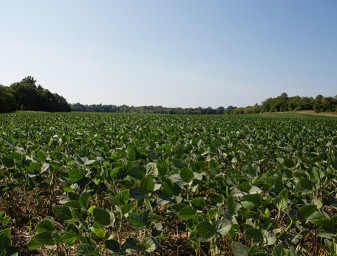
With all the things happening upstream on the Mekong River, being dammed up, this could present issues for a need for increased production as natural fisheries are affected. However, as I noted, it’s not a priority country for us. We’re looking at Indonesia, Malaysia, Myanmar, Philippines, Thailand, Vietnam as areas with large and increasing production of aquaculture products, and of course aquafeeds). Singapore and Australia are also both in our region, and while we don’t think of them as large aquaculture targets, we look at them as technology centers, and therefore areas of good potential for quality research and training.
A lot of advances in aquafeed formulations, and a reduced dependence on marine ingredients, are possible because of soy. Can you describe the behind-the-scenes work that goes into new feed formulations before they’re launched on the market? How long does it take to create a new formulation for tilapia, for instance?
Feed formulators, if they had the opportunity, ideally would formulate on a regular basis as new batches of ingredients are used with varied qualities. What you’re doing is hitting nutritional specifications, and you can use a varied matrix of ingredients based on cost and qualities to meet those targets. So when we talk about reduction of marine ingredients, one of the first reasons to do so is cost — assuming you can still meet the nutritional specifications. If you can’t do that with alternative ingredients, it tends to pull back in fishmeal, as fishmeal makes a formulator’s life easy. However, we now know a lot more about correct nutritional specifications for fish and for shrimp and prawns, which allows us to be more creative. When fishmeal and fish oil was cheap, it was easy to formulate. You didn’t have to think a lot about it; the safety factor with putting in fishmeal and fish oil is quite high. Because they’re becoming more limited, costly and because of certification standards, these two ingredients in particular are being reduced. You can create feeds using other ingredients to match those nutritional specifications, but you will need to be more creative. In any case it is not a question of how long it takes to make a formulation — an experienced formulator could create a simple one in a relatively short time.
Something to remember, however, is that a formulator cannot work in a vacuum. In order to make a successful formulation there has to be communication with the ingredient purchaser, the feed production manager and the feedmill sales and technical staff. Only in this way can a formulator create a formulation that can be produced using a given feedmill’s ingredient set and on their particular feed production machinery that also matches what the customer needs. And the other thing is, in many of these countries in Southeast Asia, some governments are putting restrictions on the maximum price of the feed, or they may actually want to approve the formulations. This could lead to cost and or time impacts we wouldn’t normally think about.
Genetically modified foods made major headlines recently when AquaBounty’s application was finally approved by the U.S. Food and Drug Administration (FDA) after a process that stretched over nearly two decades. We’ve been consuming GM plants on a massive scale for years, but GM animals for food seems to strike a nerve with consumers. Fair or unfair scrutiny?
It came down to a precautionary principle for FDA. They’re being very careful. Think about the way it was actually approved: These are not organisms that are going to be allowed in general population, or put into in cages in the ocean. They have to be in closed-off areas that aren’t going into a river or a lake. It’s not the first time animals have been genetically modified. Different terrestrial animals have been modified to produce spider silk or vaccines or different enzymes. The difference between terrestrial and aquatic livestock fish and shrimp, is that when a terrestrial animal runs away, you can typically run it down. A little bit difficult to run down a salmon once it’s gotten away. I think they’re being careful there. Did it take overly long? Yes. The safety of it was shown quite a long time ago. But there was a great concern, primarily because, what if the fish escape in the water? It’s a little bit different from a land animal. Being careful, from that standpoint, is probably wise.
“The modern crop approach [for soy] has to be GM,” you said at the 2014 GOAL. I’m assuming this is because of cost. Why does non-GM soy cost more to produce?
First of all, U.S. farmers produce both GM and non-GM strains, as do at least two of the other major producers, Argentina and Brazil. But what it comes down to is the best use of land and the best target for different strains. So you may have a GM or non-GM strain that’s appropriate for a time period, a climate and the expected weather conditions. Also, yields are very important. GM is just a faster way to reach the target qualities, as traditional biotechnology (crossbreeding) takes time. As we have to create more food for more people it has to come from somewhere. Organic, if you can afford it, is great. But to feed the general population and to continue to live a lifestyle that most people want to live, we have to use GM to produce the amount of food we need either for direct consumption or for animal feed. I’m not saying there’s no room for non-GM, or organic — there’s room for all of them. I do worry that GM feeds have been unfairly vilified. I think the science is pretty clear about the safety of GM. Billions and billions of animals have been raised on GM product.
It’s a sensitive issue, particularly in Europe, but I think that it’s worth noting that Europe is one of the largest consumers of U.S. soy for the animal feed industry. In America, GM products are rigorously reviewed, tested and licensed. Same thing in Europe — you cannot bring in an unlicensed strain of GM product, so when we hear of a refusal to allow a GM product in, it is not because it is GM, but because it is not an approved strain.
I think there’s been unfortunate scaremongering by some industries and some people about the dangers of GM. I equate it with the anti-vaccine movement, where limited bad science has been seized to try to create an artificial issue. Fortunately science is self-correcting and has a consensus mechanism. The consensus is that GM is safe, just as vaccines are safe. GM approaches have given a bit more predictability and improved the margins for farmers, but it should be remembered that most farming is done by families, and they would not take on a technology approach that is dangerous to their families or not viable for the long term.
Probably what people don’t consider also is that GM and better farming approaches have made farming much more sustainable, for example in the U.S., soybean farmers can participate in the U.S. Sustainable Soybean Assurance Protocol (SSAP) to provide a certified sustainable product. This is not just a piece of paper, the U.S. farmers have made great strides in continually improving farming methods, increasing yields while reducing fertilizer, fuel and water use. Having GM technology has helped to encourage and support more sustainable approaches.
Oilseed demand overall is increasing by 3.6 percent a year over the last 10 years. Land acreage is somewhat scarce. How can production increase, given this limitation?
Many places are still not optimizing their yields. For example, India is a large producer of soy, some 12 million metric tons. They’re producing non-GM, mostly on small-scale farms. The yields in India are not comparable to those in the United States, which is very efficient in how it produces soy. Efficiency is going to be one of the ways to increase yield, and GM is going to play a part in that, as will traditional breeding techniques for different strains.
What USSEC has done over the past few decades to aid industry is to identify the maximum amount of soy that can be used in feeds for specific species before you have a negative performance effect. This information can help formulators when they are trying to be more aggressive to create high quality, but lower cost, aquafeeds.
There’s no such thing as an all-the-time soybean farmer. All farmers choose different crops at different times. Most soybean farmers also produce corn, alfalfa and wheat, and rotate because you cannot use the same soil over and over for the same crop and also because the market changes for different crops. U.S. farmers are smart businesspeople; they watch the markets, the climate and then plant accordingly.
Overall, just as I noted for the growth of aquaculture, there is likely still a lot of room for improvement in production of oilseeds. From the farmers and experts that I have spoken to the message that I hear is that we should be fine for the short to medium term at minimum — and largely through approaches and technologies we already know about.
According to your 2014 GOAL report, USA is the global leader in soy production, followed closely by Brazil, then Argentina, and then a group of other smaller producers (China, India, Paraguay, Canada, Ukraine). Which of that group could climb the list and become a larger player in the global market?
China used to be a major soy exporter, now it is the largest importer. I don’t want to say the success of USSEC was responsible for this change, but they now are now an overwhelming consumer of soy, the largest in the world. They still produce quite a lot of soy, but it’s almost entirely for domestic human consumption. The soy they’re importing is mostly for animal feeds. This is a reverse market: First they were an exporter and now they’re an importer and if they export anything now, essentially they’re crushing beans from somewhere else.
India used to be a very large exporter to Southeast Asia and now they’re starting to use up more of their own soy. If India, which is consuming more, improves its yield, they could likely produce more, but will need more as well. Paraguay and Argentina are countries that can improve. Europe could improve production. In general, when it comes to oilseeds, not just soy, there’s still a lot of opportunity for expansion. If not land area, then on existing land area where we can produce more using better strains, with higher yielding properties and more novel approaches. Can they keep up with demand? For the short and medium term, for sure. If we have 15, 20 billion people in the world instead of the current predictions of around 9 billion, I’m not going to promise we could keep up with that!
Realistically, we should be able to produce enough. The only concerns are those unanticipated situations, like a major climate event that wreaks havoc on the one or more of the major production areas. But if we could always predict how the crops would perform, we wouldn’t be talking about this. We’d be rich! For example, two years ago we had drought in America and everyone was predicting a poor soy harvest. When the crop was harvested, we had either a normal or above average year. So you can’t always tell until the harvest actually comes in.
Now that you've reached the end of the article ...
… please consider supporting GSA’s mission to advance responsible seafood practices through education, advocacy and third-party assurances. The Advocate aims to document the evolution of responsible seafood practices and share the expansive knowledge of our vast network of contributors.
By becoming a Global Seafood Alliance member, you’re ensuring that all of the pre-competitive work we do through member benefits, resources and events can continue. Individual membership costs just $50 a year.
Not a GSA member? Join us.
Author
-

James Wright
Editorial Manager
Global Aquaculture Alliance
Portsmouth, NH, USA[103,114,111,46,101,99,110,97,105,108,108,97,97,103,64,116,104,103,105,114,119,46,115,101,109,97,106]
Tagged With
Related Posts
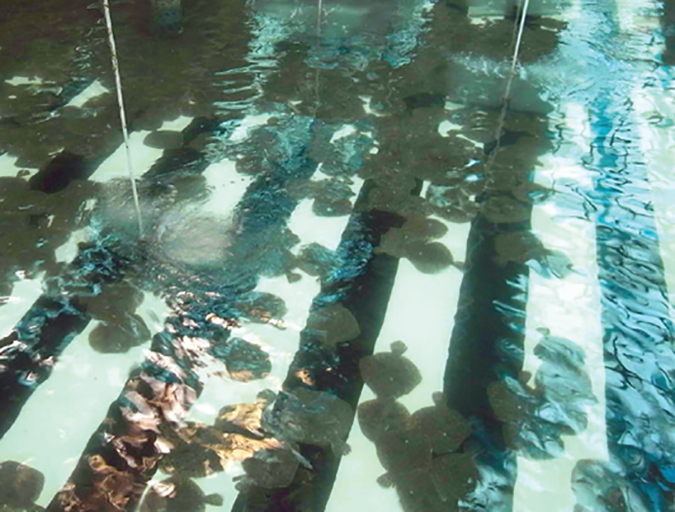
Aquafeeds
Turbot growth performance on soy-based feeds
Turbot are typically fed diets containing 45 to 65 percent fishmeal. In a study that gave turbot feed with 40 percent soy protein concentrate, the fish had decent growth and excellent survival.
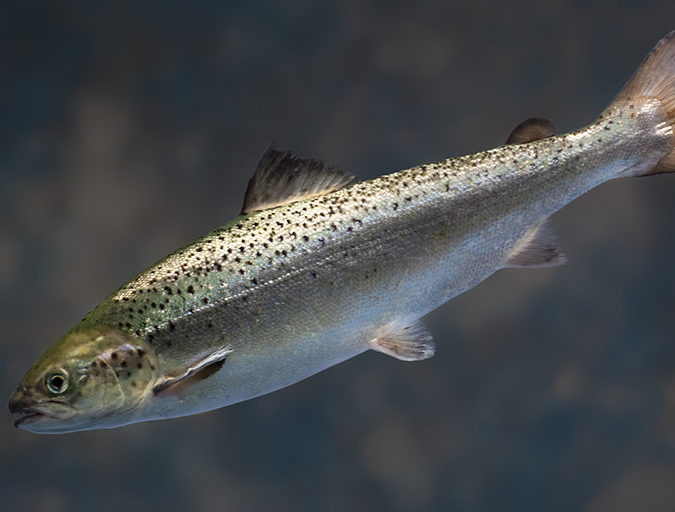
Intelligence
GM salmon and the FDA: 10 takeaways
After a 20-year process, a genetically modified fish earned U.S. Food and Drug Administration approval, reigniting one of the seafood industry’s most intriguing controversies. Here are 10 key downloads from the groundbreaking decision over AquAdvantage salmon.
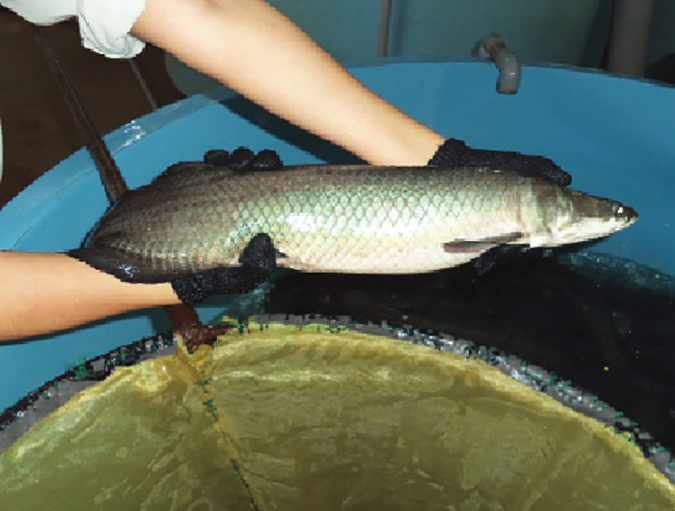
Aquafeeds
Soy-based feeds evaluated for production of Amazonian paiche
A cooperative feeding demonstration conducted by USSEC and Amazon Fish Products S.A. evaluated the use of soy to partially replace fishmeal in diets for paiche, or pirarucu, the largest freshwater fish species.
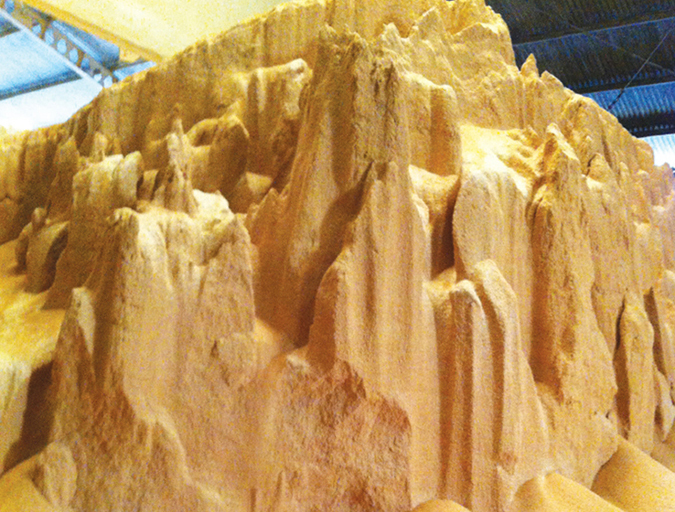
Innovation & Investment
USSEC, partners establish Asian aquaculture feed formulation database
To help produce high-quality aquaculture feeds, the U.S. Soybean Export Council spearheaded the Asian Aquaculture Feed Formulation Database project, designed as a reference tool for individuals involved in feed formulation, ingredient purchasing, quality control and research.



